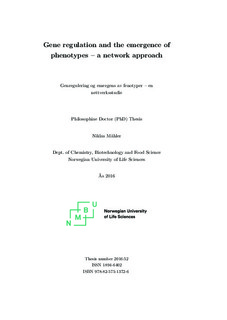Gene regulation and the emergence of phenotypes – a network approach
Doctoral thesis
Permanent lenke
http://hdl.handle.net/11250/2497003Utgivelsesdato
2018-05-03Metadata
Vis full innførselSamlinger
- Doctoral theses (KBM) [126]
Sammendrag
The emergence of complex traits in living organisms has been of interest to
biologists since the early days of biology. Domestication and breeding has
resulted in the most remarkable transformations, such as the grass teosinte
turning into the cornstalks of today, or the variation that can be seen among
different breeds of dogs. In the mid 19th century, Gregor Mendel uncovered
the basics of genetic inheritance and was able to explain the passing down of
traits in peas. Not all traits are this simple to dissect, however, since they are
controlled by several genes; these are collectively called complex traits. Due
to the large number of genes in a species, it is simply not possible to explore
the space of all gene combinations exhaustively. New sequencing technologies
however makes it possible obtain so-called omics data on multiple aspects of a
biological system and these data can be integrated in order to narrow down
the search space and focus on the functional gene combinations. Moreover,
several of these data types are much closer to the phenotype than data on
variation in genome sequence. The changes in genome sequence are manifested
as changes in gene expression levels, or changes in protein sequences in turn
leading to changes in protein function, protein interactions, metabolite levels
and gene regulation. In order to obtain a complete picture of how phenotypes
change based on changes in genome sequence, these intermediate layers must
be included as well.
In this thesis, we aim to shine some light on gene regulation and the emergence of
complex traits. In paper I, gene regulation in the cyanobacterium Synechocystis
is explored by integrating regulatory motifs with co-expression networks, and a
web tool is developed to make the results interactively available to the research
community. Paper II investigates the sexual dimorphism in Populus tremula
using data on phenotype, gene expression, and genotype. In paper III, the focus
is directed towards the genetic component of gene expression variation and
how this can be understood in the context of a co-expression network. Finally,
paper IV expands on paper III by adding genotype–phenotype associations,
in addition to eQTLs and gene expression, in order to dissect leaf shape in
Populus tremula. Uppkomsten av komplexa egenskaper i levande organismer har intresserat
biologer under lång tid. Domesticering och avel har resulterat i dramatiska
förändringar av arter, till exempel förvandlingen av gräset teosinte till dagens
majsstänglar, eller variationen vi kan se mellan olika hundraser. I mitten
av 1800-talet upptäckte Gregor Mendel de grundläggande principerna bakom
genetisk nedärvning. Dock är inte all egenskaper lika enkla att förklara då de
kontrolleras av mer än en gen. Denna typ av egenskaper kallas gemensamt
för komplexa egenskaper. På grund av det stora antalet gener i en organism
är det helt enkelt inte möjligt att utforska alla genkombinationer för att
försöka förklara dessa egenskaper. Nya sekvenseringsteknologier gör det dock
möjligt att samla så kallade omics-data som kan fånga olika aspekter av
biologiska system, och detta data kan kombineras för att reducera antalet
genkombinationer till de som mest troligt bidrar till själva egenskapen. Utöver
detta så är många av dessa datatyper “närmre” den slutgiltiga egenskapen
jämfört med genomsekvensen. Förändringar i genomsekvensen uttrycker sig
som förändringar i genuttrycksnivåer, eller förändringar i proteinsekvenser
som i sin tur leder till förändringar i funktion hos proteinerna, interaktioner
mellan proteinerna, metabolitnivåer och reglering av gener. För att kunna få en
komplett bild av hur komplexa egenskaper förändras baserat på förändringar i
genomesekvensen måste dessa mellanliggande lager av reglering inkluderas.
I denna avhandling undersöker vi genreglering of komplexa egenskaper för
att försöka få en klarare bild av hur detta fungerar. I artikel I undersöker vi
genreglering i cyanobakterien Synechocystis genom att integrera regulatoriska
motiv med co-uttrycksnätverk. Även en webbapplikation utvecklades för att
tillgängliggöra resultaten. Artikel II ser på könsdimorfism i asp (Populus
tremula) genom att använda data på fenotyper, genuttryck, samt genotyp. I
artikel III riktas fokus mot den genetiska komponenten av variation i genuttryck
och hur en klarare bild kan erhållas genom att se på detta ur perspektivet
av ett co-uttrycksnätverk. Slutligen expanderar artikel IV på resultaten från
artikel III genom att lägga till genotyp–fenotyp–associationer för att försöka
förklara skillnad i bladform hos asp.

